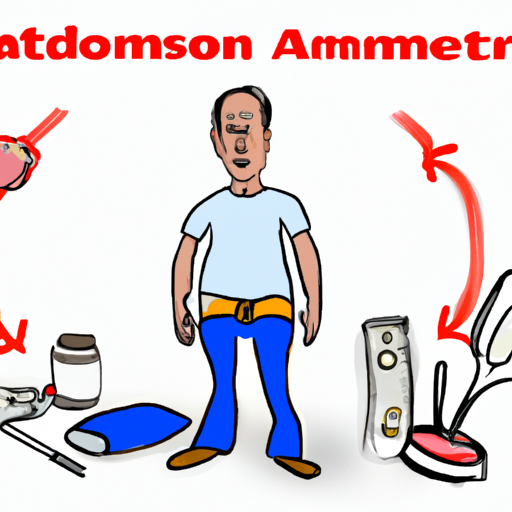Prostate adenoma, also known as benign prostatic hyperplasia (BPH), is a common condition that affects many men as they age. It is characterized by the enlargement of the prostate gland, leading to a variety of troublesome symptoms such as frequent urination, weak urine flow, and difficulty emptying the bladder completely. While there are several treatment options available for prostate adenoma, laser vaporization has emerged as an advanced and effective technique. In this article, we will delve into the understanding of prostate adenoma, its symptoms, causes, and diagnosis. We will then explore the promising field of laser vaporization as a cutting-edge treatment for prostate adenoma, discussing its benefits and potential risks. By the end of this article, you will have a comprehensive understanding of this condition and the innovative laser vaporization technique that offers hope for those suffering from prostate adenoma.
1. Understanding Prostate Adenoma: Symptoms, Causes, and Diagnosis
Prostate adenoma, also known as benign prostatic hyperplasia (BPH), is a common condition that affects a significant number of men, especially as they age. It refers to the non-cancerous enlargement of the prostate gland, leading to various urinary symptoms. Understanding the symptoms, causes, and diagnosing prostate adenoma is crucial in order to provide appropriate treatment and improve the quality of life for those affected.
Symptoms:
The symptoms of prostate adenoma can vary from mild to severe and may include a combination of the following:
1. Increased frequency of urination: Men with prostate adenoma often experience a frequent need to urinate, especially during the night (nocturia). This can disrupt sleep patterns and cause fatigue.
2. Urinary urgency: A sudden and compelling urge to urinate, which may be difficult to control, is a common symptom. This can lead to occasional urinary incontinence.
3. Weak urine flow: The enlarged prostate gland can obstruct the urethra, resulting in a weakened urine stream. This can make it difficult to initiate urination or lead to dribbling at the end of the process.
4. Incomplete emptying of the bladder: Men with prostate adenoma may feel that their bladder is not completely empty after urination. This can cause discomfort and increase the risk of urinary tract infections.
Causes:
The exact cause of prostate adenoma is not fully understood. However, hormonal imbalances, specifically the increase in dihydrotestosterone (DHT) levels with age, is believed to play a significant role. Other factors that may contribute to the development of prostate adenoma include:
1. Age: Prostate adenoma is more common in older men, with the prevalence increasing significantly after the age of 50.
2. Family history: There is evidence to suggest that genetics may influence the development of prostate adenoma. Individuals with a family history of the condition are at a higher risk.
You can find out more about this theme here: https://bbgate.com/tags/pmk/.
2. Laser Vaporization as an Advanced Treatment for Prostate Adenoma
Laser vaporization has emerged as an advanced treatment option for prostate adenoma, providing a minimally invasive and effective alternative to traditional surgical procedures. This innovative technique utilizes laser energy to precisely remove excess prostate tissue, relieving symptoms and improving the overall quality of life for patients.
Prostate adenoma, also known as benign prostatic hyperplasia (BPH), is a common condition characterized by the enlargement of the prostate gland. As men age, hormonal changes cause the prostate to grow, resulting in the compression of the urethra and subsequent urinary symptoms. These symptoms can range from mild to severe and may include frequent urination, weak urine flow, nocturia (waking up at night to urinate), and urinary retention.
Laser vaporization offers several advantages over traditional treatment options such as transurethral resection of the prostate (TURP) or open surgery. One of the key benefits of laser vaporization is its minimally invasive nature. Unlike TURP, which requires the insertion of an instrument through the urethra to remove prostate tissue, laser vaporization can be performed through a small incision or even a catheter-based approach. This reduces the risk of complications, such as bleeding or infection, and allows for quicker recovery times.
The laser energy used in vaporization is delivered through a device called a laser fiber, which is inserted into the prostate gland. The laser energy is then emitted, causing the excess tissue to vaporize or coagulate, thereby creating a wider passage for urine flow. The precision of the laser allows for targeted treatment, minimizing damage to surrounding healthy tissue and reducing the risk of complications.
Laser vaporization is also associated with reduced hospital stays and shorter recovery periods compared to traditional surgical methods. Patients typically experience less pain and discomfort after the procedure, and urinary symptoms often improve rapidly. Furthermore, laser vaporization can be performed under local or general anesthesia, depending on the patient’s preference and medical condition.
It is important to note
3. Exploring the Benefits and Risks of Laser Vaporization in Prostate Adenoma Treatment
Laser vaporization, also known as laser ablation or laser enucleation, has emerged as a viable treatment option for prostate adenoma, a condition characterized by the enlargement of the prostate gland. This minimally invasive procedure utilizes laser energy to remove or vaporize the excess prostate tissue, alleviating symptoms and improving the overall quality of life for affected individuals. However, like any medical intervention, laser vaporization comes with its own set of benefits and risks that must be carefully evaluated.
One of the primary advantages of laser vaporization is its effectiveness in treating prostate adenoma. The procedure offers comparable outcomes to traditional surgical methods, such as transurethral resection of the prostate (TURP), while minimizing the associated risks and complications. Laser vaporization is particularly advantageous for patients with larger prostate glands, as it allows for the removal of a greater volume of tissue, resulting in improved urinary flow and symptom relief.
Moreover, laser vaporization is a minimally invasive procedure, reducing the need for large surgical incisions and significantly decreasing the risk of bleeding and infections. The use of laser energy also enables precise targeting of the affected tissue, minimizing damage to surrounding structures, nerves, and blood vessels. This precision results in shorter hospital stays, faster recovery times, and reduced postoperative pain and discomfort compared to traditional surgical approaches.
Another notable benefit of laser vaporization is its ability to preserve sexual function and urinary continence. Unlike some surgical procedures, laser vaporization minimizes the risk of damaging the nerves responsible for erectile function and the urinary sphincter muscles. As a result, patients often experience fewer complications related to sexual dysfunction and urinary incontinence, which are common concerns following prostate adenoma treatment.
However, it is important to acknowledge the potential risks associated with laser vaporization. Although considered a safe procedure, there is a risk of complications such as bleeding, infection, urinary tract injury, and urinary retention. Additionally, some patients may experience temporary urinary symptoms such as urgency, frequency, and


